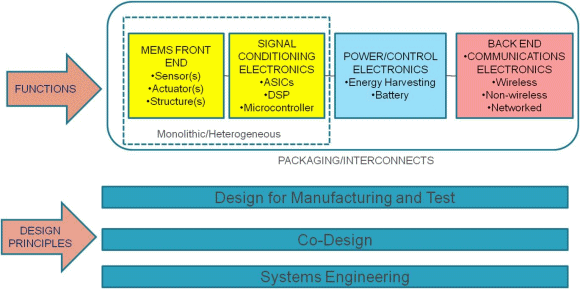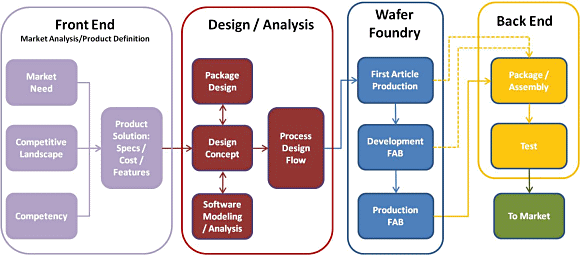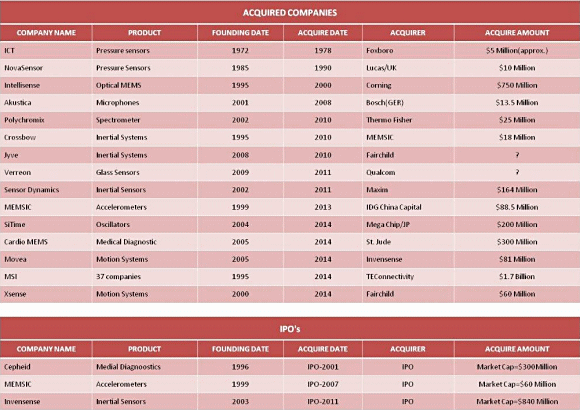
Introduction
This second part of the Creation of Wealth discussion will provide several recently-conducted interviews with leading MEMS serial entrepreneurs who have created wealth for themselves, their employees, and investors. These include Joe Mallon, who started NovaSensor (now Amphenol) and came aboard in the early days of Measurement Specialties as its CEO. He shares his creation of wealth experience from an acquirer's perspective.
As a word of caution is needed, the number of MEMS entrepreneurs is quite limited as compared to other industries. The stories provided represent several of the major success stories of serial MEMS entrepreneurs and should provide some valuable lessons learned from MEMS Millionaires. Figure 1 is a summary of acquisitions and IPO's that appeared in the previous episode.
Discussion
Founding and selling nine MEMS companies, Janusz Bryzek, PhD may be the king of MEMS entrepreneurs. Beginning in his native Poland, Janusz's first exposure to MEMS was designing process control pressure sensors for an instrument company. His first job in the US was at Foxboro ICT in 1979 as a design engineer developing disposable blood pressure sensors.
Janusz's recommendations for creating wealth with MEMS include:
- Develop a product/service where there is no other choice for the customer but yours.
- Address a market segment that is growing at a compounded annual rate of at least 25% and has a market size of at least $100 Million based on equivalent product solutions.
- The application/technology also needs to be high on the Gartner hype curve.
Asked what is the secret sauce for successfully selling a MEMS company, "I have sold several companies based on the fact that we have enabled our acquirers to better attain their technology roadmap objectives." And for a successful IPO, "device suppliers will find it quite difficult, you need to sell solutions, a higher level of value added functionality to augment the basic MEMS device" (see figure 2).

Fig. 2: MEMS-Based System Solutions add functionality to the MEMS front end of sensors/actuators and structures to maximize value added.
Kurt Petersen, PhD started his MEMS career in 1975 as an IBM researcher and has been a successful serial entrepreneur with the founding/co-founding of four MEMS-based companies:…NovaSensor (MEMS pressure sensors), Cepheid (microfluidic bio sensing-based systems ), SiTime (MEMS system timing products), and Verreon (glass-based sensors).
Asked what makes a successful MEMS entrepreneur, Petersen states, "It depends on the company. At NovaSensor it was creating MEMS-based solutions that pushed the envelope of design and process technology. Here we created products that were head and shoulders above the competition for customers that had real and viable applications. At Cepheid, which had a very successful IPO, our approach was to create a total solution, not just the PCR microfluidic chip, but an entire instrument which it enabled and as such leveraged its technology. Here we eliminated the uncertainty of working with a middle man and became a solution provider, maximally leveraging the uniqueness of our MEMS device and maximizing value added. For SiTime, we had the perfect storm, a unique MEMS-based resonator technology licensed from Bosch, a huge market of $5 billion crystal oscillators, which we expected to replace, and finally we funded and implemented a well planned and executed product positioning and launch program. Although it took us longer than expected to achieve our goals due to unforeseen technical problems, we just sold the company to a Japanese company, MegaChips for $200 million. This is noteworthy since SiTime's current annual sales is $20 Million thus creating a 10:1 ratio when most companies are acquired in the 2:1 to 3:1 range. Finally, Verreon was sold to Qualcomm based on the enabling nature of the glass-based sensing technology which they considered a highly leverageable strategic technology for their mobile phone business."
Sandeep Arakaju has been quite successful in his creation of wealth activities over his 20 year career. His first success was as a member of the management team at Intellisense, which was sold to Corning for $750 Million during the height of the telecom boom in 2001 and most recently with the sale of Jyve to Fairchild. As a partner of Janusz Bryzek at Jyve, they and their team created a monolithic three axis accelerometer/three axis gyro combination for mobile phone applications.
Sandeep's secret of success is, "spotting trends early on, like surfing, where you see the wave that you want to ride far offshore. It takes a great deal of market research to best understand the customers' needs and then to provide a solution to what is relevant, analogous to what surfboard to use and which wax to apply (see figure 3). This is an applications /market pull and not a technology push strategy". Additionally, "you need to be intimately involved in the game and connect with lots of clever people. Good market research is critical, however it is more than just talking with customers. You need to understand the underlying sociological and psychological trends and understand the market's pain points in order to come up with the right product."

Fig. 3: Extensive market research is necessary to create products that are unique and address the unfulfilled need of the marketplace. They are the first step in the MEMS commercialization process and are the basis of a successful MEMS product launch strategy.
Joe Mallon started his MEMS career in 1965 at Kulite Semiconductor and went on to start NovaSensor in 1985 with Janusz Bryzek and Kurt Petersen. There are many unique accomplishments that Joe has under his belt including starting Measurement Specialties Inc. (MSI) on an acquisition path, acquiring four companies while he was CEO, all being sensor related.
As for Joe's formula for acquiring sensor companies, "When I came to MSI as CEO in 1995, we had solid piezoresistive sensor expertise, a small operation in Hong Kong, and solid China manufacturing experience with a partner in Shenzhen, China. I realized that we could leverage all this to create higher value added OEM sensors, using the excellent low cost manufacturing available in China. We started with the MSP line of all media pressure sensors. Once we established that product line and built our own Shenzhen manufacturing plant, it was time to look at acquiring organizations. We looked at sensor companies with annual revenues of at least $10 million with marginal profitability, high manufacturing costs, and, most important, that could gain competitive advantage from lower cost manufacturing. Additionally, we could consolidate sales and distribution channels of each of these acquired companies with existing manufacturing reps, and distribution channels and save significant administrative costs."
Acquiring Amp Sensors, TRW Sensors, IC Sensors, and Terraillon, Joe, may be the first sensor empire builder in the industry Through astute deal making, he was able to accomplish acquisitions at 30% to 80% of annual sales. Joe left MSI in 2003, subsequently taking an advanced degree at Stanford University while MSI continued on an accelerated path of sensor acquisitions. Recently, MSI was acquired by TE Connectivity for $ 1.6 Billion. Obviously, Joe's early sensor acquisitions at MSI were a catalyst for this huge success story.
The next episode will conclude the summary of interviews with Joe Brown, Jim Knutti, Richie Payne, Job Elders, and Steve Nasiri. Additionally, their recommendations will provide you with the secret sauce of becoming a MEMS Millionaire.
About the Author
Roger H. Grace is president of Roger Grace Associates (Naples, FL) which he founded in 1982 as a marketing consultancy serving the sensor, MEMS, IC and capital equipment markets. He holds the B.S.E.E. and M.S.E.E. (as a Raytheon Company Fellow) degrees from Northeastern University where he was awarded the Engineering Alumni of the Year Award in 2004. He was a visiting lecturer at the University of California at Berkeley College of Engineering from 1990 to 2004. He can be contacted via email at [email protected].
Related Stories
MEMS Commercialization Report Card Research Project, Part Two
MEMS Commercialization Report Card, Episode 3: Technology Clusters
MEMS Commercialization Report Card, Episode 4: Industry Associations
2013 MEMS Commercialization Report Card, Part 5: Standards & Roadmaps
2013 MEMS Commercialization Report Card, Part 6: MEMS Infrastructure & Market Research
MEMS Commercialization Report Card, Part 7: Creation of Wealth, Part One
